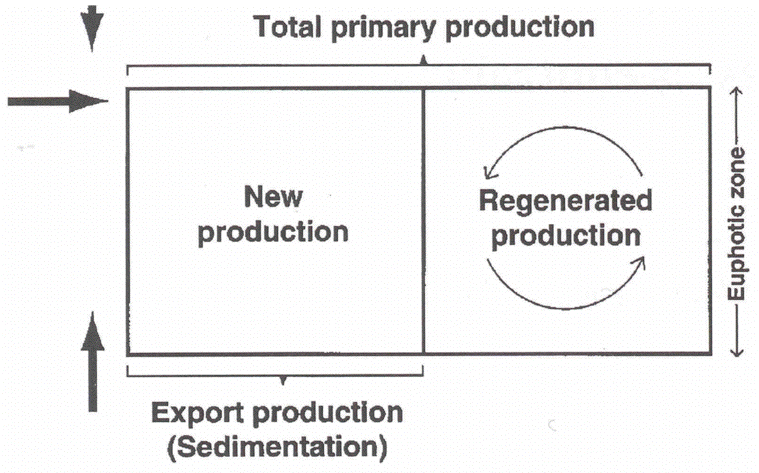


 |  |  | 8.3 Primary production and vertical export |
Primary production consists of new production (PN) that is based on allochthonous, i.e. externally supplied nutrients, and regenerated production (PR), which is based on autochthonous, i.e. internally recycled nutrients [139]. Hence total primary production (PT) is the sum of PN and PR. The amount of carbon that enters the aphotic zone is entitled export production (PE) (Figure 2).

The concept of new production is of utmost importance for understanding natural and eutrophicated ecosystems because the fraction f = PN/PT represents the upper limit of organic matter and energy which can be removed or extracted from the surface waters of the system without destroying the long-term integrity of pelagic systems [483][244][285]. PN represents thus the biomass that has to be handled by an eutrophicated recipient (e.g. mineralization, accumulation, harvestable biomass and export of biomass to adjacent recipients). Given the importance of PN for the over-all cycling of organic matter, considerable emphasis has recently been given to estimating PN in coastal (e.g. Wassmann, [487]) as well as oceanic environments (e.g. Knauer et al. [267]). New production represents the carrying capacity of a marine ecosystem. New production represents the maximum production capacity of an ecosystem or the harvestable production. New production is a critical component of marine primary production that limits the supply of food to the benthos, zooplankton, fish, and extensive aquaculture as well as the removal rate of atmospheric CO2 by the marine biota. New production estimates are of great interest for understanding eutrophication. Increased new production results in additional biomass that the ecosystem has to deal with in terms of grazing, vertical export to the bottom and pelagic and benthic degradation.
Given the practical difficulties in estimating PN for lengthy periods of time, sediment traps can be used to estimate PN. PE estimates as measured by sediment traps come close to PN, but are always smaller because it comprises only the particulate fraction and some transformation takes place from ammonium to nitrate even in the upper layers. Calculations of the productivity index f by applying PE give, therefore, rise to underestimates [489]. As a consequence, the term e = PE/PT can be applied and used as an approximation of f. In boreal, coastal areas where steady state, if at all, cannot be assumed for intervals of less than the length of the productive period, e is meaningful as a base for estimating f for lengthy periods only (e.g. >6 months). Therefore, the term <e>, representing e for lengthy periods of time will be applied.
 |  |  | 8.3 Primary production and vertical export |